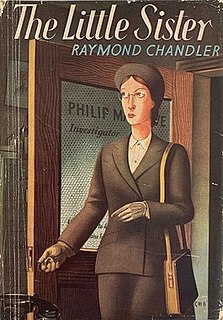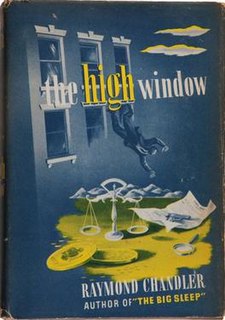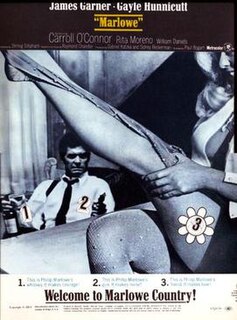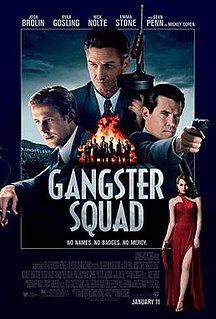Related Research Articles

Raymond Thornton Chandler was an American-British novelist and screenwriter. In 1932, at the age of forty-four, Chandler became a detective fiction writer after losing his job as an oil company executive during the Great Depression. His first short story, "Blackmailers Don't Shoot", was published in 1933 in Black Mask, a popular pulp magazine. His first novel, The Big Sleep, was published in 1939. In addition to his short stories, Chandler published seven novels during his lifetime. All but Playback have been made into motion pictures, some more than once. In the year before his death, he was elected president of the Mystery Writers of America.

The Big Sleep (1939) is a hardboiled crime novel by American-British writer Raymond Chandler, the first to feature the detective Philip Marlowe. It has been adapted for film twice, in 1946 and again in 1978. The story is set in Los Angeles.

Philip Marlowe is a fictional character created by Raymond Chandler. Marlowe first appeared under that name in The Big Sleep, published in 1939. Chandler's early short stories, published in pulp magazines like Black Mask and Dime Detective, featured similar characters with names like "Carmady" and "John Dalmas".

The Blue Dahlia is a 1946 American crime film and film noir, directed by George Marshall based on an original screenplay by Raymond Chandler. The film stars Alan Ladd and Veronica Lake. It was Chandler's first original screenplay.

Farewell, My Lovely is a novel by Raymond Chandler, published in 1940, the second novel he wrote featuring the Los Angeles private eye Philip Marlowe. It was adapted for the screen three times and was also adapted for the stage and radio.

Murder, My Sweet is a 1944 American film noir, directed by Edward Dmytryk and starring Dick Powell, Claire Trevor and Anne Shirley. The film is based on Raymond Chandler's 1940 novel Farewell, My Lovely. It was the first film to feature Chandler's primary character, the hard-boiled private detective Philip Marlowe.

The Lady in the Lake is a 1943 detective novel by Raymond Chandler featuring the Los Angeles private investigator Philip Marlowe. Notable for its removal of Marlowe from his usual Los Angeles environs for much of the book, the novel's complicated plot initially deals with the case of a missing woman in a small mountain town some 80 miles (130 km) from the city. The book was written shortly after the attack on Pearl Harbor and makes several references to America's recent involvement in World War II.

Playback is a novel by Raymond Chandler featuring the private detective Philip Marlowe. It was first published in Britain in July 1958; the US edition followed in October that year. Chandler died the following year; Playback is his last completed novel.

This Gun for Hire is a 1942 American film noir crime film directed by Frank Tuttle and starring Veronica Lake, Robert Preston, Laird Cregar, and Alan Ladd. It is based on the 1936 novel A Gun for Sale by Graham Greene.

The Big Sleep is a 1946 American film noir directed by Howard Hawks, the first film version of the 1939 novel of the same name by Raymond Chandler. The film stars Humphrey Bogart as private detective Philip Marlowe and Lauren Bacall as Vivian Rutledge in a story about the "process of a criminal investigation, not its results". William Faulkner, Leigh Brackett and Jules Furthman co-wrote the screenplay. In 1997, the U.S. Library of Congress deemed the film "culturally, historically, or aesthetically significant," and added it to the National Film Registry.

The Little Sister is a 1949 novel by Raymond Chandler, his fifth featuring the private investigator Philip Marlowe. The story is set in Los Angeles in the late 1940s. The novel centres on the younger sister of a Hollywood starlet and has several scenes involving the film industry. It was partly inspired by Chandler's experience working as a screenwriter in Hollywood and his low opinion of the industry and most of the people in it. The book was first published in the UK in June 1949 and was released in the United States three months later.

The Trials of Nikki Hill is a legal thriller written by Christopher Darden and Dick Lochte, and published Time Warner Company in 1999.

The High Window is a 1942 novel written by Raymond Chandler. It is his third novel featuring the Los Angeles private detective Philip Marlowe.

Dirt is an American television serial broadcast on the FX network. It premiered on January 2, 2007 and starred Courteney Cox as Lucy Spiller, the editor-in-chief of the first-of-its-kind "glossy tabloid" magazine DirtNow, which was previously two separate publications: dirt and Now. A 13-episode second and final season was announced on May 8, 2007. Only seven episodes were produced prior to the 2007 WGA strike shut down production. The shortened second season began airing on March 2, 2008. The show was created by Matthew Carnahan and produced by Coquette Productions and ABC Studios. On June 8, 2008, FX canceled the series after two seasons.

Marlowe is a 1969 American neo-noir film starring James Garner as Raymond Chandler's private detective Philip Marlowe. Directed by Paul Bogart, the film was written by Stirling Silliphant based on Chandler's 1949 novel The Little Sister.

School Days (2005) is a work of detective fiction by American author Robert B. Parker, the 33rd in his acclaimed Spenser series.

The Falcon Takes Over, is a 1942 black-and-white mystery film directed by Irving Reis. The B film was the third, following The Gay Falcon and A Date with the Falcon (1941), to star George Sanders as the character Gay Lawrence, a gentleman detective known by the sobriquet the Falcon.

Gangster Squad is a 2013 American action thriller film directed by Ruben Fleischer, written by Will Beall, and starring Josh Brolin, Ryan Gosling, Nick Nolte, Emma Stone, Anthony Mackie, Giovanni Ribisi, Robert Patrick, Michael Peña, and Sean Penn. Set in 1949, the plot is a fictionalized account of the LAPD officers and detectives, called the 'Gangster Squad', who attempt to keep Los Angeles safe from Mickey Cohen and his gang.
"Blackmailers Don't Shoot" is a short story by Raymond Chandler. It was first published in December 1933 in the magazine Black Mask.
"Nevada Gas" is a short story by writer Raymond Chandler. It was first published in June 1935 in the magazine Black Mask. The "Nevada gas" of the title refers to cyanide gas, used for executions in the state of Nevada at the time.
References
- ↑ Widdicombe, Toby. A Reader's Guide to Raymond Chandler. Greenwood Publishing Group, 2001, p. 15.
- ↑ Hiney, Tom. Raymond Chandler: A Biography.. Grove Press, 1999, p. 83.
- ↑ "Contents Lists". www.philsp.com.